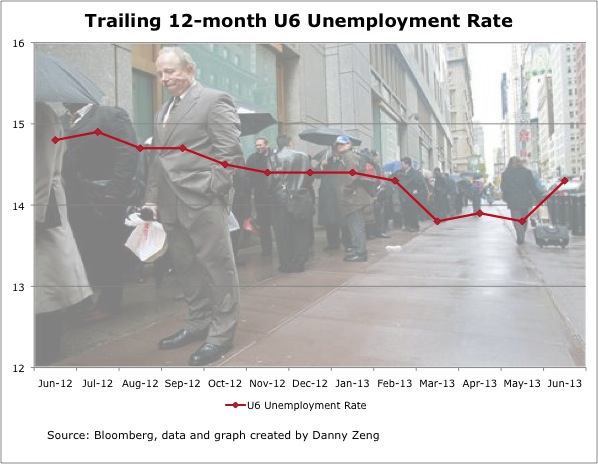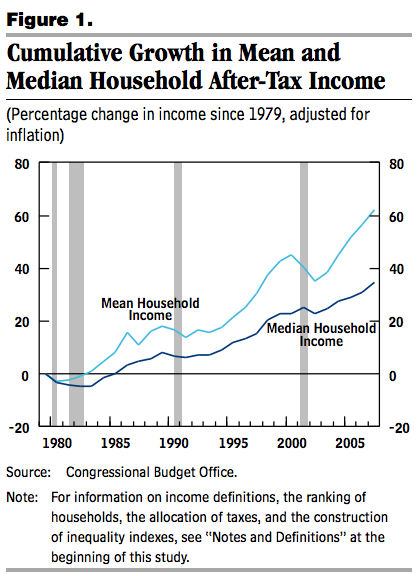
The Liberal Trifecta Photo Courtesy of liberalwhoppers.com
Danny Zeng | August 13, 2013
(A similar version of this article was first published on PolicyMic on August 12th, 2013)
The President’s recent economic speech in Knox College and the intense subsequent media interest have prompted me to explore the following often-misused economic statistics by Liberals:
1. Unemployment Rate. Whenever the official U.S. monthly unemployment rate ticks down, it becomes world news. I often receive my monthly BLS job report on Twitter: 7.4% for July. While the official rate had gone down slightly from June, and far from the 10% we saw a few years ago, this statistic is overrated and masks weaknesses in the labor market. The official government unemployment rate is an incomplete indicator of joblessness: It does not count those who have stopped looking for work, and it says nothing about net change in jobs as compared to expectation from economists — we came under expectation in July. About 4 million people gave up looking for work in July. Many jobs created were part-time, partly as result of businesses’ wariness regarding Obamacare compliance. In order to boost employment numbers and avoid political backlash, the White House recently suspended enforcement of the employer mandate in Obamacare for one year, a desperate attempt to spur job growth prior to the 2014 election, even if it means shooting themselves in the foot.

The U6 unemployment rate, which is the broadest reported indicator that accounts for underemployment and those who are only “marginally attached to the workforce,” still stands at 14%. This statistic remained flat for the last 12 months. While the official unemployment rate has gone down marginally, we still have 11.5 million people without work. That should be our top focus as a country and we should not pat ourselves on the back every month when the number fluctuates slightly in either direction.
2. Median Household Income. The president said in the same speech at Knox College, “The average American earns less than what he or she did in 1999.” I scratched my head and thought maybe the president was referring to census numbers that show a reduction in median household income. If so, his statement accounts solely for income and fails to assess wealth gained during the period. The census definition of income excludes taxes and non-cash benefits. This method would peg a rich, retired couple with much wealth in financial securities as poor, as their income will be dramatically less as result of retirement. Using a more extreme example, assume the U.S. government takes all of our income and redistributes it back to us through transfers. Our median household income would be zero, despite the fact that we’ll have government transfers to sustain household consumption. Therefore, the measure does not capture financial well-being and consumption very well. Average (mean or median) American households have actually gained in after-tax income, according to the CBO graph. According to economists Bruce Meyer and James Sullivan, median income and consumption both rose by more than 50% in real terms between 1980 and 2009.

The President continues: “this growing inequality not just of result, inequality of opportunity — this growing inequality is not just morally wrong, it’s bad economics. Because when middle-class families have less to spend, guess what, businesses have fewer consumers.” Scott Winship of Brookings discussed the effect of inequality, growth, and opportunity back in April, saying there is scant evidence that supports the proposition that inequality hampers growth. The President here also unveils the premise of his economic worldview. He seems to believe that consumption creates demand that then creates supply. According to this logic, the economic remedy would simply constitute putting more dollars into the pockets of middle-class families. Where are these dollars coming from? Businesses themselves? Or Government? The President seems to suggest that more middle-class spending power could come from the rich (mathematically it wouldn’t make sense for it to come from the poor). If only would the rich share their slice of the pie (redistribution), then businesses will thrive. He is not talking about opportunity here; the President is talking about redistribution. How does spending more money solve the “inequality of opportunity” if not for us to have the same “opportunity” to spend more? And “spend more” necessarily implies more dollars, whose origins I’ve discussed above must come from the rich. Thus, this is a loopy argument that mistaken income for consumption, which in turn distorts economic policy. Unless, of course, one buys into the argument that redistribution constitutes wealth-creation…























